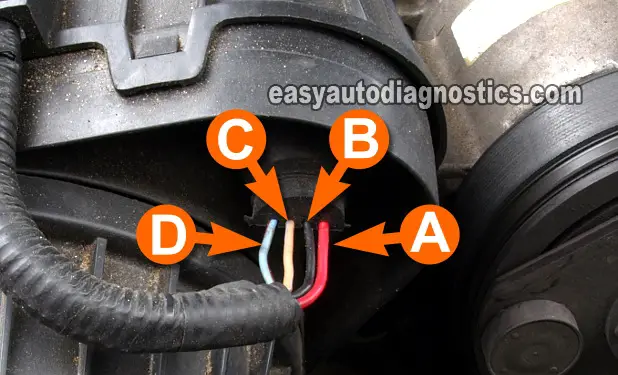
The MAF sensor on your 3.8L V6 Ford Mustang can be testes with a multimeter in 4 easy steps. You don't need a scan tool to troubleshoot a bad MAF Sensor or a MAF Sensor Code. This article will show you how with step by step instructions.
Although the MAF sensor on your Ford Mustang is inside the round air filter canister assembly and hidden from view, you don't have to take it apart to test the MAF sensor.
Contents of this tutorial:
![]() You can find this tutorial in Spanish here: Cómo Probar El Sensor MAF: 3.8L Ford Mustang (at: autotecnico-online.com).
You can find this tutorial in Spanish here: Cómo Probar El Sensor MAF: 3.8L Ford Mustang (at: autotecnico-online.com).
APPLIES TO: This tutorial applies to the following vehicles:
- Ford Mustang 3.8L: 1994, 1995, 1996, 1997, 1998, 1999, 2000, 2001, 2002, 2003
If you're looking for the article on how to test the Ford MAF Sensor that's not inside the air filter canister assembly, go here: How To Test The Ford Mass Air Flow (MAF) Sensor.
Common Symptoms Of A Bad Ford MAF Sensor
The check engine light will definitely be lit, on your instrument cluster, and your Ford Mustang may also display one or several of the following symptoms:
- MAF Codes that light up the check engine light (CEL) on your instrument cluster.
- P0102: MAF Signal Low Input to PCM.
- P0103: MAF Signal High Input to PCM.
- MAF sensor malfunction that DOES NOT light up the check engine light (CEL).
- Lean and/or Rich code(s).
- Fuel Trim code(s).
- A tremendous lack of power upon acceleration.
- Black smoke coming from the tail-pipe.
- Bad gas mileage.
- Vehicle may idle rough and stall.
Circuit Descriptions Of The Ford MAF Sensor's Connector

The mass air flow sensor on your Ford Mustang has four wires (circuits) coming out of the Plastic Round Air Filter Canister. Each one has a specific job to do and below are those 'job descriptions':
- Letter A:
- Power (12 Volts) Circuit.
- Letter B:
- Power Ground Circuit.
- Letter C:
- Sensor Ground Circuit (provided by PCM).
- Letter D:
- MAF Sensor Signal.
To test these circuits you'll need to use a tool to pierce the wire to be tested. I recommend using a wire-piercing probe since it'll be the most effective and easiest way of getting to the signal. If you need to see what this tool looks like, click here: Wire-Piercing Probe. Independent of the method you use, be careful not to damage the wire(s). Take all safety precautions.
Another important thing to note is that the color of the wires (coming out of your Mustang) does not matter. In other words, the circuit description/job of the wire is the same regardless of year and color of the wire.
IMPORTANT: All of the tests are ON CAR TESTS, do not remove the mass air flow sensor from the vehicle or from its plumbing.
How Does The MAF Sensor Work?
Knowing how the MAF sensor works on your Ford Mustang will help you to understand the tests you're about to perform. So here in a nutshell is what happens when the crank and start the car:
- The MAF sensor gets power (12 Volts) and Ground. Ground is provided by two different circuits. One Ground circuit goes directly to the battery negative (-) terminal. The second Ground circuit is provided by the PCM internally.
- When the engine finally starts and idles, the MAF sensor provides a voltage of about 1 Volt DC. This voltage may fluctuate a bit since it depends on the amount of air flow the engine needs to warm up and stuff.
- Now, as you accelerate the engine, the throttle opens. This lets more air into the engine.
- This increase in air flow is sensed by the MAF sensor and it in turn converts this increase in airflow into an increasing voltage signal that the PCM uses to know that more air is entering the engine.
Now, just to recap the above info, the MAF signal's DC voltage is directly related to amount of air the engine is breathing. Therefore, if the engine is breathing in more air at 2500 RPMs that at an idle of 900RPMs the voltage output will be greater at 2500 RPMs than at idle.
Now, when testing this voltage signal, the important thing to know is not an actual Volts number at a specific RPM, but to look for crazy and extreme fluctuations in the voltage signal that do not correspond to the actual air intake (RPMs) of the engine or no Signal at all. For example: If at Idle the voltage reading starts to spike up and down without you accelerating the engine or if there's no signal at all.
In the TEST 4 section of this article, I'll show how you'll use a base voltage reading at idle from the MAF sensor that will help you to confirm that the MAF sensor is bad or not.
TEST 1: Testing The MAF Signal

To get our MAF sensor diagnostic started, we're gonna check the MAF signal coming out of the MAF sensor on your Mustang.
The most common type of MAF sensor failure is a sensor that does not produce a signal or a signal that stays stuck at a certain voltage regardless of engine RPM.
Now, the engine has to be at its normal operating temperature for this test. So, start the engine and let it reach it's normal operating temperature. You'll be using the voltage reading you will obtain at idle as a base to diagnose the MAF sensor.
The MAF sensor on your Ford Mustang must be connected to its connector to perform this test.
Let's get started:
- 1
With the key in the OFF position.
- 2
With a suitable tool connected to the red multimeter test lead, probe the letter D circuit of the MAF sensor connector shown in the photo.
- 3
Put the multimeter in Volts DC mode.
- 4
Connect the black multimeter test lead to the battery (-) negative terminal.
- 5
Start the already warmed up engine.
- 6
Note the Volts reading on your multimeter at idle. This voltage reading usually hovers somewhere around 0.9 to 1 Volt DC. This reading may be stable (with only small fluctuations) or unstable with very extreme fluctuations. No matter what the instability in the reading, this will be your base reading.
- 7
Accelerate the engine (by manually opening the throttle) as you watch the multimeter's voltage readings.
At about 1500 RPMs you'll see about 1.4 Volts DC.
At around 2500 RPMs the multimeter should register around 1.8 Volts DC.
The actual voltage reading on your multimeter may/will vary slightly. - 8
Now, when you close the throttle and the engine returns to idle, the multimeter should display the voltage value that you observed in test step 6 (about 0.9 to 1 Volt DC).
- 9
Repeat this as often as you need to verify that the voltage numbers on the multimeter rise smoothly every single time.
- 10
If the MAF sensor is good, the voltage value should go up as you accelerate the engine and should go down as the engine return to idle. These readings will not spike up and down crazily.
Let's interpret your test result:
CASE 1: The multimeter showed a smooth increase and decrease as you manually opened and closed the throttle. This result confirms that the MAF sensor on your Mustang is functioning correctly.
If the MAF sensor was defective, it would've stayed stuck at a specific voltage value no matter how much you revved the engine.
CASE 2: The multimeter DID NOT show a smooth increase and decrease as you manually opened and closed the throttle. This result usually tells you that the MAF sensor on your Mustang is bad and needs to be replaced.
To make sure the MAF sensor is bad, you need to make sure it's getting power and Ground. For the next test, go to: TEST 2: Testing The Power (12 V) Circuit.
